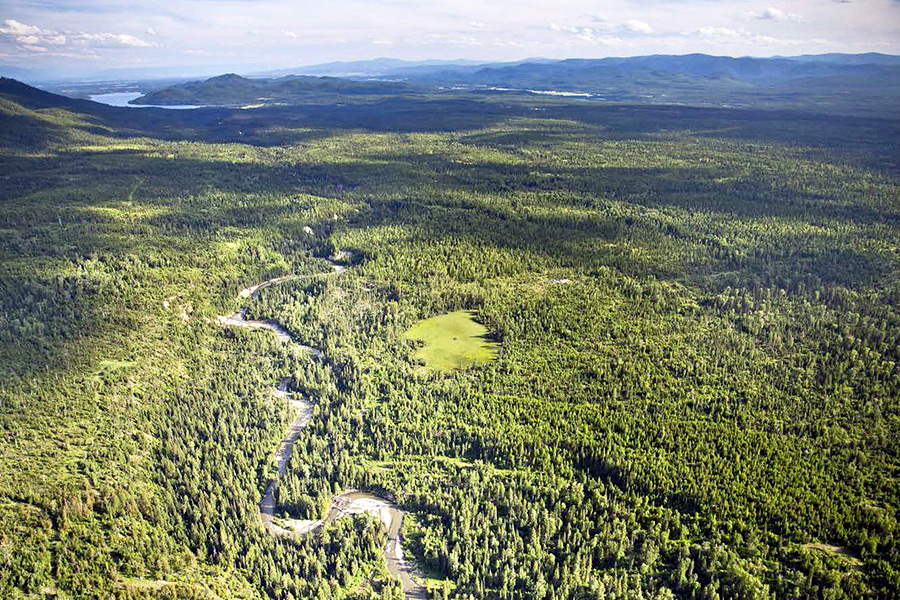Whitefish Lake Watershed Project Receives $2 Million in Federal Funding
Montana congressional delegation announces funds to preserve open land near Whitefish
By Tristan Scott
Montana’s congressional delegation has secured $2 million in funding for the sprawling, multi-phase Whitefish Lake Watershed Project, which furnishes permanent protections on 15,334 acres of prime multiple-use land flanking the lake’s northern shore.
The conservation and recreation community praised the easement because it protects critical fish and wildlife habitat and provides continued public access for outdoor recreation, while also securing the city of Whitefish’s water supply, 20 percent of which is drawn from Whitefish Lake.
Coupled with the nearby Haskill Basin project on land owned by F.H. Stoltze Land and Lumber Co. — the source of the city’s remaining water supply — the Whitefish Lake Conservation Project affords the final safeguard from threats of development on land owned by the Weyerhaeuser Company.
The most recent round of funding was made available through the U.S. Fish and Wildlife Service, and administered by the Land and Water Conservation Fund (LWCF), which is financed by federal revenues from energy companies drilling for oil and gas in public waters offshore.
Alan Wood, regional wildlife mitigation coordinator for Montana Fish, Wildlife and Parks, said the agency applied for the federal funding last year and was relieved by the news that it had been awarded.
“We submitted the application and then held our breath and crossed our fingers until it was awarded,” Wood said. “It was certainly good news, and we are grateful that the Fish and Wildlife Service offered us the full $2 million that we requested.”
FWP also applied for additional funding under the Forest Legacy Program, which caps at $7 million, and received among the highest priority rating in the nation.
The watershed-scale project, including the Haskill Basin and Trumbull Creek easements, comes with a total cost of nearly $40 million, and is the culmination of years of work by land managers and environmental groups who recognized the development pressure that could bear down on the prized landscape surrounding Whitefish Lake, which is bordered by the Stillwater State Forest and laced with creeks and tributaries that provide critical habitat to grizzly bear, lynx, bull trout, cutthroat trout, elk, wolves, and white-tail deer in the state.
It marks one of the most complex land swaps in state history, according to public land managers, and protects a block of land that sees among the heaviest concentrations of multiple-use in Montana — it is a working forest, a recreational haven, and the source of the lion’s share of Whitefish’s municipal water supply.
Turn on the tap in Whitefish and the trickle of water that springs forth likely originated from the cold, clean headwaters of Haskill Creek.
A mile-and-a-half north of Whitefish Lake lies a rarefied mix of forested parcels, creeks, tributaries, and low wetlands, offering key wildlife habitat connectivity and migration paths between the Stillwater State Forest, the Whitefish Range and the Cabinet Purcell Mountain corridor, as well as prime bull trout habitat.
Last year, the Trust for Public Land and Plum Creek (now Weyerhaeuser) struck an agreement to conserve the timber giant’s forested property north of Whitefish Lake, an area with high real estate potential.
Under the agreement, the Trust for Public Land (TPL) will purchase 1,920 acres and establish a conservation easement on the remaining 13,414 acres, which Weyerhaeuser will continue to own and manage as a working forest. The purchased lands will eventually be transferred into public ownership or to a conservation buyer. The agreement is subject to final conditions including appraisal and secured funding.
U.S. Sens. Steve Daines, a Republican, and Democrat Jon Tester, alongside U.S. Rep. Ryan Zinke, a Republican from Whitefish, all championed the project and lauded its bipartisan support in a letter to Dan Ashe, director of the U.S. Fish and Wildlife Service.
“This investment will conserve the outdoor way of life in the Whitefish area, protect critical investments in water quality for the City of Whitefish, secure working forests and protect habitat important to many of Montana’s rare and iconic wildlife species,” the delegation stated in the letter.
“It’s great news that we were able to secure additional funds to help protect Montana’s natural resources and preserve it for future generations,” Daines stated in a news release on Sept. 15. “The Whitefish Lake Watershed Project is another example of the critical role LWCF in conservation and recreation in our local communities.”
“I am thrilled that Montana’s Congressional delegation was able to come together and secure these funds for the Whitefish Lake Watershed Project,” added Tester. “Folks come from around the world to see the beauty of Whitefish Lake and thanks to LWCF and the Whitefish Lake Watershed Project this land will be preserved for future generations of sportsmen and women.”
“This grant is proof of what’s possible when our delegation works together,” Zinke stated. “Growing up in Whitefish, I developed a special appreciation for both our land and water and the timber industry and how the two can complement each other. I’m happy to see this project succeed and will continue to be a fighter for the Land and Water Conservation Fund in Congress.”